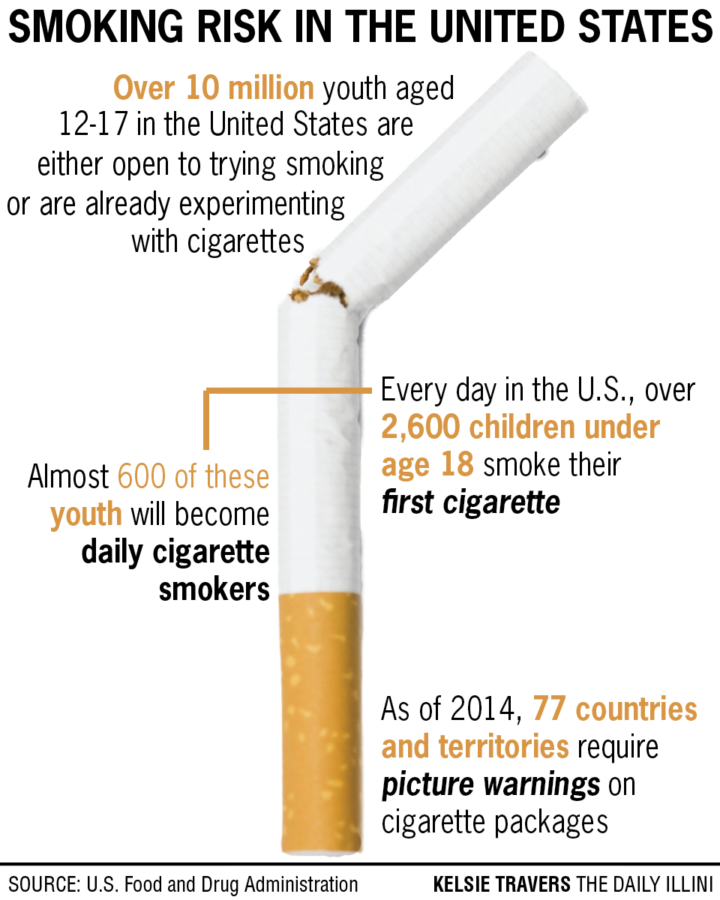Anti-smoking ads’ effectiveness questioned in University study
March 8, 2016
Rotting teeth, blackened lungs and a corpse. Graphic May Not Be Ready Yet – Please Check
When Nicole LaVoie, a doctoral student in communication, saw the newly proposed anti-smoking ads that the Food and Drug Administration plans to put on cigarette packages, she said she found the images, “absolutely disgusting and disturbing.”
LaVoie studies high-risk health safety topics, such as smoking and drinking, as well as the “unintended consequences of different ways that we try to promote certain health safety spheres.”
University undergraduate students participated in LaVoie’s study, which tested the students to see how they would react to the images.
According to the published study, the FDA selected images, including pictures of diseased lungs, a diseased mouth, a person dying of lung cancer and a corpse.SO
Get The Daily Illini in your inbox!
“My original hypothesis was that people who saw these images would have an increase in what we call psychological reactance,” LaVoie said. “Psychological reactance is when people don’t like a particular message, they feel like it’s threatening them in some way or that it’s threatening their ability to choose freely to do something.”
LaVoie predicted that the participants wouldn’t like the images, and that they would come to see the source — in this case the government — as over-reaching and domineering. The results of the study went on to support her predictions.SO
“The psychological reactance theory is that these warnings can be perceived as authoritative, freedom-oppressing and threatening. They’re often met with resistance and exposure to these graphic labels can be perceived as a freedom threat,” Brian Quick, communication professor and co-author of the study, said. “These images aren’t effective, based off of the results of this study. The images were not well received. They felt pressure that they were being told what to do, (and that it) stripped them of their ability to choose.”
The aim of the image labels is to reduce smoking rates.
“More than 10 million youth (12 to 17 years-old) in the United States are either open to trying smoking or are already experimenting with cigarettes — meaning they have tried fewer than 100 cigarettes in their lifetime,” according to the FDA’s website on anti-smoking campaigns. “In fact, every day in the United States, more than 2,600 youth under age 18 smoke their first cigarette—and nearly 600 youth under age 18 become daily cigarette smokers.”SO
LaVoie said the labels may help with prevention; but with cigarettes displayed openly in gas stations and drug stores across the country, all consumers — smokers and non-smokers — will be exposed to the images, potentially making consumers upset. In fact, some consumers who purchase cigarettes even purchase covers so that they don’t have to look at the labels.
“Ultimately, it’s questionable whether consumers will purchase (fewer) cigarettes because of (the labels). Whether it actually helps reduce consumption is in question,” LaVoie said. “But we do know it makes people feel very angry and uncomfortable and negative toward the government. It has wide-ranging implications for all consumers because everybody has to see them.”
When LaVoie researched the use of the image labels in other countries she found the labels were released in conjunction with other efforts to reduce cigarette sales.SO
“(The other countries) have put into place tax increases on cigarettes, and new cigarette smoking bans in certain places,” she said. “What they’re looking at is the combination of the images, plus the taxes, plus the smoking ban, and overall there might be a reduction.”
LaVoie and Quick’s research led them to discern that using methods of fear are not the most effective methods to spark a decrease in behavior.
“The United States is always trying to find new ways to help people make better health choices. But we have to be a lot more careful about how we go about doing that,” LaVoie said. “Is there another way where we might be able to design messages to get the point across where we’re not angering people?”







